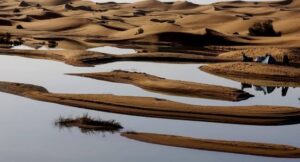A rare and much-needed rainstorm has brought life back to the deserts of southeastern Morocco, turning parched sands into temporary wetlands and rejuvenating a region known for its harsh, arid climate. The unprecedented downpour created ponds and lakes that now dot the landscape of Merzouga, a popular tourist destination located about 600 kilometers from Rabat, Morocco’s capital. Both locals and visitors see the unexpected transformation as a gift, describing it as a sign of hope amid a historic drought that has plagued Morocco for years.
In the heart of Merzouga, Yasmina Lake—a basin long dried up—has regained some of its former beauty. Youssef Ait Chiga, a local guide leading a tour for German visitors, described the rains as a much-needed miracle. “We couldn’t be happier,” he said. “The desert, once barren, now boasts water bodies that reflect the blue sky, making it a sight to behold.” For Khalid Skandouli, another guide, the rainfall has added an unexpected twist, drawing even more tourists eager to witness the desert in its rare, vibrant state.
This September’s rainfall is remarkable not only for its volume but also for its rarity, with residents saying it has been nearly two decades since the desert’s basins held this much water. The recent floodwaters, however, have not come without consequences. Torrential rains swept across Morocco’s south, claiming at least 28 lives. As the desert bloomed with life, the nation also grappled with the risks of flash floods in its arid regions, underscoring the complexity of such rare weather events.
Neighboring Algeria also experienced similar heavy rains and floods in early September, with six reported fatalities. Experts believe these unusual storms might be linked to shifting climate patterns. Morocco’s meteorological agency recently reported that the significant rainfall could be attributed to an atypical movement of the intertropical convergence zone, where northern and southern winds collide, spurring storms in regions unaccustomed to such weather.
Also, read; CAF Awards Nigeria 3 Points After Libya AFCON Qualifier Cancellation
“This shift is likely due to climate change,” said Moroccan climate scientist Fatima Driouech. “But we’ll need comprehensive research to confirm this connection.” Climate specialists are increasingly concerned about how global warming intensifies extreme weather events, whether prolonged droughts or unexpected storms.
In Morocco, these rains provide a momentary respite for a country experiencing its most severe drought in four decades. Last year, the country faced its driest period in 80 years, with a 48% decrease in rainfall, putting tremendous strain on agriculture—a sector employing over a third of Morocco’s population. The recent rains have partially replenished some reservoirs and groundwater reserves in the south, yet experts warn that consistent rainfall is necessary to make a substantial difference.
Tourists, too, have been taken by surprise. Jean Marc Berhocoirigoin, a Frenchman who last visited Merzouga 15 years ago, expressed awe at seeing Yasmina Lake revived. “It’s like returning to a childhood memory,” he shared. “The sight is magical, and I never expected to see it like this again.”
For now, Morocco’s desert stands transformed, a temporary oasis that embodies both the beauty and unpredictability of nature. As North Africa continues to contend with a deepening water crisis, this rare rain event has revived a sense of resilience and the understanding that while climate patterns may shift, life finds a way to endure.
